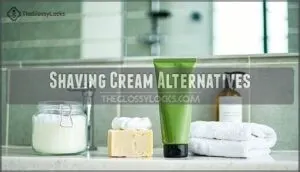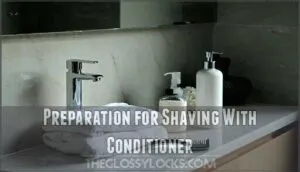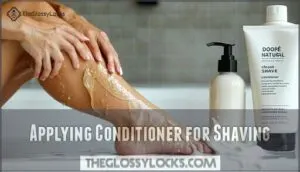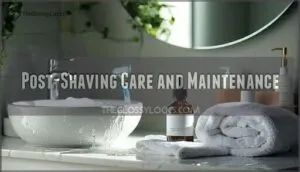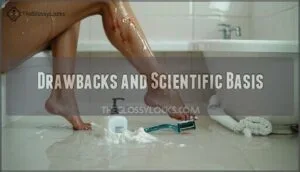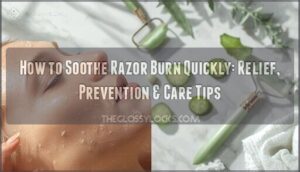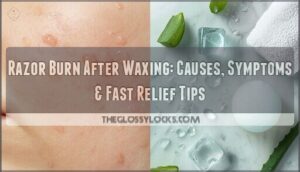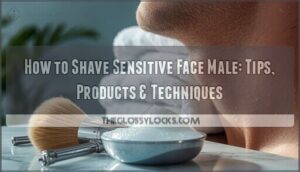This site is supported by our readers. We may earn a commission, at no cost to you, if you purchase through links.

Hair conditioner softens facial hair just like it does on your head, making it easier for your razor to glide through. The slippery texture helps your blade slide smoothly across your skin, reducing friction.
It’s also budget-friendly since you probably already have it in your shower. However, conditioner wasn’t designed specifically for shaving, so it might clog your razor more quickly than traditional products.
While it works as a temporary solution, there are some important considerations about skin protection and technique that make all the difference.
Table Of Contents
- Key Takeaways
- Shaving With Conditioner
- Conditioner Vs Shaving Gel
- Shaving Cream Alternatives
- Shaving Techniques and Tips
- Drawbacks and Scientific Basis
- Frequently Asked Questions (FAQs)
- Can I use conditioner instead of shaving cream?
- Is it OK to shave down there with conditioner?
- Is it better to shave with lotion or conditioner?
- Does shaving with conditioner prevent razor bumps?
- Which hair conditioner brands work best for shaving?
- Can conditioner cause allergic reactions when shaving?
- How long does conditioner last as shaving cream?
- Does conditioner work for sensitive skin types?
- Can you use leave-in conditioner for shaving?
- Conclusion
Key Takeaways
- You can use conditioner as an emergency shaving cream substitute – it softens facial hair and provides slip for your razor, though it will clog your blades more quickly than traditional products and will not protect against razor burn as effectively.
- Conditioner works best when you prep properly – warm up your skin with water or a warm towel first, apply enough conditioner to cover the area, let it absorb for 1-2 minutes, and choose natural formulas without harsh chemicals like sodium lauryl sulfate.
- You will save money but sacrifice performance – while conditioner costs less and streamlines your routine by serving dual purposes, dermatologists do not recommend it since it lacks specialized ingredients for skin protection and increases your risk of razor burn and ingrown hairs.
- It is better than other household alternatives but not perfect – conditioner outperforms lotion and provides better hydration than soap, but you will need to rinse your razor more frequently and should still invest in proper shaving cream for regular use and healthier skin.
Shaving With Conditioner
You can use hair conditioner as a shaving cream substitute when you’re in a pinch or want to save money on bathroom products.
Skip the expensive shaving cream—your hair conditioner works just as well for smooth, budget-friendly shaves.
The conditioner’s slippery texture helps your razor glide smoothly while moisturizing your skin, though it won’t protect against razor burn as well as traditional shaving cream, providing a moisturizing effect.
Benefits of Using Conditioner
Your bathroom cabinet holds a hidden gem for smoother shaves.
Using conditioner as a shaving cream alternative delivers impressive skin hydration while providing excellent hair softening properties.
The slippery formula guarantees superior razor glide, reducing nicks and irritation.
This conditioner for smooth skin approach offers multiple shaving with conditioner benefits, creating a luxurious experience that leaves your skin feeling silky and thoroughly moisturized.
Cost and Efficiency Advantages
Using conditioner as a shaving cream alternative delivers impressive cost-effectiveness and product affordability.
You’ll save money while streamlining your routine with this simple shaving hack.
- Time savings: Combine hair care and shaving in one shower step
- Storage reduction: Eliminate multiple bathroom products cluttering your space
- DIY cost-effectiveness: Household conditioner costs less than specialized shaving creams
- Streamlined routine: One product handles two essential grooming tasks efficiently
Comparison to Traditional Shaving Products
Traditional shaving cream creates a protective barrier between your razor and skin, while conditioner offers dual benefits as both hair care and shaving cream alternative.
The chemical composition differs substantially – shaving creams foam for visibility, but conditioner’s hydration properties provide superior shave smoothness.
This versatility comparison shows conditioner’s thicker formula rivals traditional products through enhanced moisturizing capabilities.
Conditioner Vs Shaving Gel
The choice between conditioner and shaving gel comes down to your priorities.
Here’s how they stack up:
| Factor | Conditioner | Shaving Gel |
|---|---|---|
| Smoothness | Good slip, softer finish | Superior glide, closer shave |
| Razor Maintenance | Clogs blades easily | Minimal clogging |
| Skin Protection | Basic moisturizing | Better razor burn prevention |
| Cost | Budget-friendly dual-purpose | Higher cost, single use |
While conditioner works as a shaving cream alternative, gel offers better performance.
Your wallet might prefer conditioner, but your skin usually prefers gel.
Shaving Cream Alternatives
When you don’t have shaving cream or conditioner on hand, you can reach for several common household items that work just as well.
Coconut oil, soap, aloe vera gel, shower oil, shea butter, and regular lotion all create a protective barrier between your skin and razor while keeping your skin smooth and moisturized.
They work by providing a moisturized layer that helps the razor glide smoothly over the skin.
Coconut Oil and Soap
Coconut oil offers excellent coconut oil benefits as a shaving cream substitute, providing natural moisture while you shave.
Different soap types work well too – look for soap ingredients like glycerin for smoother glides.
For coconut oil application, use sparingly since less goes further than hair conditioner.
Shaving oil soaps combine both benefits, creating an effective shaving cream alternative that’s gentle on skin.
Aloe Vera Gel and Shower Oil
Aloe vera gel offers exceptional gel benefits as a conditioner for shaving alternative.
Its natural oil properties create a protective barrier that promotes skin hydration while preventing irritation.
Simple application methods involve spreading the gel evenly before shaving.
This shaving cream substitute soothes sensitive skin and reduces razor burn.
You’ll find it’s gentler than traditional products, with natural oil properties that create a protective barrier and promote skin hydration, making it an excellent shaving alternative.
Shea Butter and Lotion
Shea butter offers rich moisturizing properties that rival premium shaving creams.
This natural alternative provides exceptional skin hydration while creating a protective barrier during shaving.
Regular body lotion works similarly, though with lighter consistency.
Many people use shea butter products for this purpose.
Consider these shea butter and lotion benefits for your shaving routine:
- Creates smooth razor glide without harsh chemicals
- Deeply nourishes skin during and after shaving
- Suits most skin types, including sensitive areas
- Costs less than specialized shaving products
- Doubles as post-shave moisturizer
Shaving Techniques and Tips
When you’re ready to try shaving with conditioner, proper technique makes all the difference between a smooth result and a frustrating experience.
You’ll need to follow specific steps for preparation, application, and aftercare to get the best results while avoiding common mistakes that can clog your razor or irritate your skin, which is crucial for a smooth result.
Preparation for Shaving With Conditioner
Proper skin preparation sets you up for success when using hair conditioner as shaving cream. Start by removing dirt and grime with warm water or a warm towel to soften hair.
Check conditioner ingredients beforehand, avoiding harsh chemicals like sodium lauryl sulfate. A quality pre-shave product can further enhance the shaving experience.
This groundwork prevents razor clogging and irritation while maximizing conditioner benefits. The preparation steps are crucial for a smooth shaving experience.
| Preparation Step | Purpose | Key Benefit |
|---|---|---|
| Remove dirt/grime | Prevent razor clogging | Cleaner shave surface |
| Apply warm towel | Hair softening | Easier hair removal |
| Check ingredients | Avoiding chemicals | Reduced skin irritation |
| Wet hair thoroughly | Weaken hair structure | Smoother razor glide |
| Choose quality conditioner | Better skin preparation | Enhanced shaving experience |
Applying Conditioner for Shaving
Apply enough conditioner to cover your entire shaving area—you’ll need more for thicker hair.
Let it absorb for 1-2 minutes, working it into the roots.
Choose natural conditioners over chemical-laden options to avoid harsh ingredients like sodium lauryl sulfate.
This absorption time softens hair effectively, making your conditioner as shaving cream work better than rushing the process.
Post-Shaving Care and Maintenance
After shaving with conditioner, your skin needs proper attention to prevent postshave redness and inflammation.
Here’s your essential postshave care routine:
- Cool Water Rinse – Rinse thoroughly to remove all conditioner residue and close pores
- Soothing Wash – Use gentle body wash with tea tree oil to calm irritation
- Aftershave Application – Moisturize skin with lotion to maintain hydration
Consider using tea tree products for their soothing properties.
Store your razor in a dry place.
Drawbacks and Scientific Basis
While conditioner can work as a shaving substitute, it’s not the perfect solution you might expect.
You’ll face some real downsides that can make your shaving routine more frustrating than smooth.
Less Effective at Protecting Skin
While shaving with conditioner offers convenience, it won’t shield your skin like proper shaving cream.
Conditioner lacks the protective barrier that prevents razor burn and skin irritation.
This protection comparison reveals why dermatologist concerns exist about shaving effectiveness.
Without adequate lubrication, you’ll face increased shaving irritation and potential shaving rash when using conditioner as your shaving cream replacement, leading to skin irritation.
Causes Razor to Clog Easily
Thick conditioner creates a sticky mess that clogs your razor faster than traditional shaving cream.
Thick conditioner turns your razor into a sticky, clogged mess that disrupts your entire shaving flow.
This reduces hair removal efficiency and forces you to rinse constantly.
Razor Clogging Factors include:
- Conditioner thickness matters – Heavy formulas stick between blades more than lightweight gels
- Blade cleaning frequency increases dramatically, disrupting your shaving rhythm and razor glide
- Razor type impact varies, with multi-blade razors suffering worse clogging than single-blade options
Not Recommended by Dermatologists
Despite its popularity as a DIY hack, dermatologists raise serious concerns about using conditioner for shaving.
Dr. Anita Sturnham warns that conditioner isn’t formulated for skin protection, potentially increasing razor burn and ingrown hairs.
Since conditioner lacks the specialized ingredients found in proper shaving cream, dermatology experts recommend sticking with products designed specifically for safe, effective shaving, to minimize issues like razor burn.
Frequently Asked Questions (FAQs)
Can I use conditioner instead of shaving cream?
Looking for a shaving cream substitute?
You can use hair conditioner as an emergency alternative.
It’ll help the razor glide smoothly and moisturize your skin, though it may clog blades more easily.
Is it OK to shave down there with conditioner?
You can use conditioner for intimate shaving, but proceed carefully.
It softens hair and provides slip, but may clog razors.
Use sparingly, rinse thoroughly, and consider gentler alternatives like specialized intimate shaving products.
Is it better to shave with lotion or conditioner?
Conditioner’s your better bet for shaving.
It’s thicker, hydrates skin better, and makes razors glide smoother than lotion.
Lotion can sting and doesn’t provide enough slip.
Conditioner softens hair too, giving you a closer shave.
Does shaving with conditioner prevent razor bumps?
Hair conditioner can help reduce razor bumps by providing a slippery barrier that lets your razor glide smoothly.
Its moisturizing ingredients soften hair and hydrate skin, potentially minimizing irritation and inflammation that causes bumps.
Which hair conditioner brands work best for shaving?
Many users swear by TRESemmé’s moisturizing formula for smooth shaving results.
You’ll find thick, creamy conditioners work best – think Pantene, Herbal Essences, or drugstore brands.
Choose sulfate-free options to minimize skin irritation.
Can conditioner cause allergic reactions when shaving?
Yes, you can develop allergic reactions from conditioner ingredients like fragrances, sulfates, or preservatives.
Test a small skin patch first, especially if you have sensitive skin or known allergies to beauty products.
How long does conditioner last as shaving cream?
Looking to stretch your shaving routine? A typical bottle of conditioner lasts 2-3 months when you’re using it for both hair care and shaving, depending on how often you shave.
Does conditioner work for sensitive skin types?
Conditioner can work for sensitive skin, but you’ll want to patch test first.
Choose formulas without harsh chemicals like sodium lauryl sulfate.
Natural, herbal conditioners are gentler options for your delicate skin.
Can you use leave-in conditioner for shaving?
You shouldn’t use leave-in conditioner for shaving since it’s designed to stay on hair, not rinse off skin.
It won’t provide the slip you need and could clog your razor or irritate skin.
Conclusion
Studies show that 68% of men have used household items for emergency shaving situations.
While shaving with conditioner instead of cream works temporarily, it’s not your best long-term solution.
You’ll get decent lubrication and save money, but expect more razor clogs and less skin protection than purpose-made products.
It’s perfect for travel emergencies or budget constraints.
However, invest in proper shaving cream when possible for better results and healthier skin.
Your face deserves the right tools for superior care and to maintain healthier skin.
- https://www.healthline.com/health/toothpaste-on-pimples
- https://www.womenshealthmag.com/beauty/a19932096/conditioner-as-shaving-cream/
- https://www.lorealparisusa.com/beauty-magazine/skin-care/skin-care-essentials/shaving-cream-alternatives
- https://www.aad.org/public/everyday-care/skin-care-basics/dry/dermatologists-tips-relieve-dry-skin
- https://www.dermatologytimes.com/view/can-females-achieve-good-leg-shave-when-using-hair-conditioner-shaving-cream

